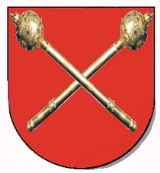
Hetmans of Polish-Lithuanian Commonwealth
Encyclopedia
 |
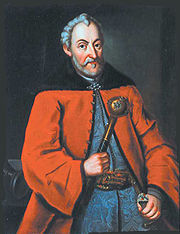 |
 |
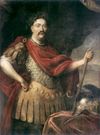 |
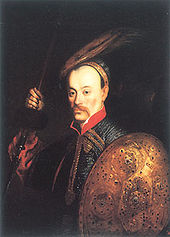 |
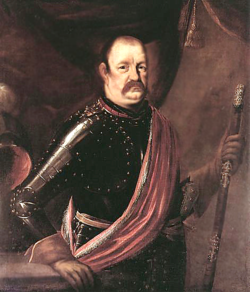 |
Hetmans of the Polish–Lithuanian Commonwealth were the highest-ranking military officers, second only to the King, in the Polish–Lithuanian Commonwealth. The first Polish title of Grand Crown Hetman was created in 1505. The title of hetman
Hetman
Hetman was the title of the second-highest military commander in 15th- to 18th-century Poland and the Grand Duchy of Lithuania, which together, from 1569 to 1795, comprised the Polish-Lithuanian Commonwealth, or Rzeczpospolita....
was given to the leader of Polish Army and till 1581 it was awarded only for a specific campaign or war. Later it became a permanent title, as did all the titles in the Kingdom of Poland and Polish–Lithuanian Commonwealth. It could not be revoked unless treachery had been proven (from 1585). Hetmans were not paid for their job by the Royal Treasury.
Field and Great Hetmans
From the end of 16th century there were two hetmans in the Grand Duchy of LithuaniaGrand Duchy of Lithuania
The Grand Duchy of Lithuania was a European state from the 12th /13th century until 1569 and then as a constituent part of Polish-Lithuanian Commonwealth until 1791 when Constitution of May 3, 1791 abolished it in favor of unitary state. It was founded by the Lithuanians, one of the polytheistic...
and two hetmans in the Crown
Crown of the Polish Kingdom
The Crown of the Kingdom of Poland , or simply the Crown , is the name for the unit of administrative division, the territories under direct administration of Polish nobility from middle-ages to late 18th century...
: a Field Hetman and a Great Hetman (sometimes translated as Grand Hetman). So there were in total four hetman titles: Great Crown Hetman, Field Crown Hetman, Great Lithuanian Hetman and Field Lithuanian Hetman. During joint military operations of the Crown and Grand Duchy of Lithuania armies, the Crown Great Hetman usually was considered superior to others hetmans and served as commander-in-chief if the war actions ran along the borders of the Grand Duchy and vice versa.
Grand Hetmans were usually in command of the professional and mobilised army and during peace stayed at the capital involving themselves in politics, guarding the interests of the army and planning campaigns.
Polish Field Hetman was subordinates of Grand Hetman and when on the same battlefield commanded the mercenaries and artillery
Artillery
Originally applied to any group of infantry primarily armed with projectile weapons, artillery has over time become limited in meaning to refer only to those engines of war that operate by projection of munitions far beyond the range of effect of personal weapons...
. During peace they usually were deployed on the eastern and southern borders of the Commonwealth, and commanded all local forces against constant skirmishes and small invasions of the Ottoman Empire
Ottoman Empire
The Ottoman EmpireIt was usually referred to as the "Ottoman Empire", the "Turkish Empire", the "Ottoman Caliphate" or more commonly "Turkey" by its contemporaries...
and its vassals. Field Hetman were also called Frontier Hetman, since they did the same job as commanders of frontier garrisons before the title of hetman was introduced.
Lithuanian Field Hetman initially was called Court Hetman and commanded the guard of the Grand Duke, while Land Hetman commanded militia. Later this difference disappeared and they were renamed Field and Great Hetmans accordingly. Contrary to Polish practice Lithuanian Field Hetman had full control on army under his command and wasn't subordinated to the Great Hetman.
For a short period there was also an office of Royal Court Hetman, but it never gained much influence.
Responsibilities and privileges
Hetman's competences and privileges, first officially described in 1527 in the act of nomination for Jan TarnowskiJan Tarnowski
Jan Amor Tarnowski was a Polish szlachcic . He was Grand Crown Hetman from 1527 and was the founder of the city of Tarnopol, where he built the Ternopil Castle and the Ternopil Lake....
included:
- planning and carrying out of military campaigns
- enlistment and organisation of professional army (wojsko kwarcianeWojsko kwarcianeWojsko kwarciane was the term used for regular army units of Poland . The term was used from 1562.Wojsko kwarciane was formed from earlier obrona potoczna units....
) and mercenariesMercenaryA mercenary, is a person who takes part in an armed conflict based on the promise of material compensation rather than having a direct interest in, or a legal obligation to, the conflict itself. A non-conscript professional member of a regular army is not considered to be a mercenary although he... - supervision of registered Cossacks and atamanAtamanAtaman was a commander title of the Ukrainian People's Army, Cossack, and haidamak leaders, who were in essence the Cossacks...
s, who were chosen by hetmans for two-year terms - nomination and promotion of officers at will
- choosing locations where the army units were to draw supplies from (that could become a severe burden of cities/nobles that were disliked by a hetman)
- supervising the flow of the army's finances (including the soldiers' wages)
- full control over military judiciary (with capital punishmentCapital punishmentCapital punishment, the death penalty, or execution is the sentence of death upon a person by the state as a punishment for an offence. Crimes that can result in a death penalty are known as capital crimes or capital offences. The term capital originates from the Latin capitalis, literally...
during wars), they could also issue laws and regulations for the army (known as hetman's articles) - hearing complaints of all civilian personnel against the army and issuing compensation
- hetmans had certain competencies in foreign affairsForeign AffairsForeign Affairs is an American magazine and website on international relations and U.S. foreign policy published since 1922 by the Council on Foreign Relations six times annually...
, they could send their own emissaries to countries such as the Ottoman EmpireOttoman EmpireThe Ottoman EmpireIt was usually referred to as the "Ottoman Empire", the "Turkish Empire", the "Ottoman Caliphate" or more commonly "Turkey" by its contemporaries...
, MoldaviaMoldaviaMoldavia is a geographic and historical region and former principality in Eastern Europe, corresponding to the territory between the Eastern Carpathians and the Dniester river...
, Crimean Chanate and WallachiaWallachiaWallachia or Walachia is a historical and geographical region of Romania. It is situated north of the Danube and south of the Southern Carpathians...
. It was reasoned that the distance to capital was too large and situation in that regions was always too volatile for all decisions to be made in the capital (KrakówKrakówKraków also Krakow, or Cracow , is the second largest and one of the oldest cities in Poland. Situated on the Vistula River in the Lesser Poland region, the city dates back to the 7th century. Kraków has traditionally been one of the leading centres of Polish academic, cultural, and artistic life...
, later WarsawWarsawWarsaw is the capital and largest city of Poland. It is located on the Vistula River, roughly from the Baltic Sea and from the Carpathian Mountains. Its population in 2010 was estimated at 1,716,855 residents with a greater metropolitan area of 2,631,902 residents, making Warsaw the 10th most...
)
The hetman had no right to order the forces of the royal court, the royal guard, units equipped by the cities and towns, or private individuals, although during wars those units often voluntarily pledged their obedience to hetmans. Hetmans had no control over the navy, although the Polish Navy
Polish Navy
The Marynarka Wojenna Rzeczypospolitej Polskiej - MW RP Polish Navy, is the branch of Republic of Poland Armed Forces responsible for naval operations...
was always of very limited importance. Hetmans usually had no direct control over the levy (pospolite ruszenie
Pospolite ruszenie
Pospolite ruszenie , is an anachronistic term describing the mobilisation of armed forces, especially during the period of the Polish-Lithuanian Commonwealth. The tradition of wartime mobilisation of part of the population existed from before the 13th century to the 19th century...
), but they could give orders to the regimentars
Regimentarz
Regimentarz was a military commander since the 16th century in Poland, of an army group or substitute of Hetman, nominated by the King or the Sejm....
who commanded it.
While hetmans were considered to be among the highest ranking officials in the Polish–Lithuanian Commonwealth, their hetman status gave them no right to sit in either the Senate or Sejm
Sejm
The Sejm is the lower house of the Polish parliament. The Sejm is made up of 460 deputies, or Poseł in Polish . It is elected by universal ballot and is presided over by a speaker called the Marshal of the Sejm ....
, unless they held another office that automatically carried with it a seat or were elected as a representatives of local szlachta
Szlachta
The szlachta was a legally privileged noble class with origins in the Kingdom of Poland. It gained considerable institutional privileges during the 1333-1370 reign of Casimir the Great. In 1413, following a series of tentative personal unions between the Grand Duchy of Lithuania and the Kingdom of...
during sejmik
Sejmik
A sejmik was a regional assembly in the Polish–Lithuanian Commonwealth, and earlier in the Kingdom of Poland. Sejmiks existed until the end of the Commonwealth in 1795 following the partitions of the Commonwealth...
s. Each hetman received a hetman's ceremonial mace
Ceremonial mace
The ceremonial mace is a highly ornamented staff of metal or wood, carried before a sovereign or other high official in civic ceremonies by a mace-bearer, intended to represent the official's authority. The mace, as used today, derives from the original mace used as a weapon...
, the bulawa
Bulawa
The bulawa is a ceremonial mace or baton. The word is of Turkish origin....
, as the symbol of his position (it was added to his coat of arms
Coat of arms
A coat of arms is a unique heraldic design on a shield or escutcheon or on a surcoat or tabard used to cover and protect armour and to identify the wearer. Thus the term is often stated as "coat-armour", because it was anciently displayed on the front of a coat of cloth...
). Less common was a horse-tail ensign and hetman's sign
Hetman's sign
The hetman's sign was the only native military symbol of the Polish-Lithuanian Commonwealth. It was invented by hetman Jan Tarnowski, who also popularized it on the territory of Poland in the second half of the sixteenth century. In Lithuania the hetman's sign was accepted in the following...
.
In some of the never realised plans of reconstruction of the Polish–Lithuanian Commonwealth from dual into triple state (Polish-Lithuanian-Ruthenian Commonwealth
Polish-Lithuanian-Ruthenian Commonwealth
Polish–Lithuanian–Ruthenian Commonwealth was a proposed European state in the 17th century that would replace contemporal Polish–Lithuanian Commonwealth. The creation of a Duchy of Ruthenia was considered at various times, particularly during the 1648 Cossack insurrection against Polish rule in...
), the hetman was to be a head of the Ruthenian part, consisting of three Ukrainian voivodeship
Voivodeship
Voivodship is a term denoting the position of, or more commonly the area administered by, a voivod. Voivodeships have existed since medieval times in Poland, Romania, Hungary, Lithuania, Latvia, Russia and Serbia....
s (see Treaty of Hadiach
Treaty of Hadiach
The Treaty of Hadiach was a treaty signed on 16 September 1658 in Hadiach between representatives of the Polish-Lithuanian Commonwealth and Cossacks...
).
The reform in 1776 limited the powers of the hetmans.
Hetman's aides
A hetman's chief aides and officers included:- pisarz polny – field chancellor, responsible for the archives, chancery, finances, accounting of people, equipment and fortifications, and paying soldiers' wages
- straznik – guardian; security; supervised the scout forces during movement and camping and commanded the front guard (however, if both hetmans were present, the Field Hetman acted as Great Guardian (Polish: Wielki Straznik)).
- obozny – camp leader; camp and transport organisation; responsible for choosing a suitable camping place for an army, setting up the camp, logistics and security inside the encampment.
- szpitalny – medic; medical services
- profos – military juridiciary
- brabanmajster – logistics
- regimentarz – second-in-command in the event a hetman was killed or taken prisoner; the regimantrz could also be chosen by the king for a given period when a hetman was not available, or informally assumed this function of the commander-in-chief when no hetman or monarch was present nearby (for example, the commander of a levee en massePospolite ruszeniePospolite ruszenie , is an anachronistic term describing the mobilisation of armed forces, especially during the period of the Polish-Lithuanian Commonwealth. The tradition of wartime mobilisation of part of the population existed from before the 13th century to the 19th century...
was usually called a regimentarz.
Most of those aides also had a Field/Great and Crown/Lithuanian add-ons to their titles, depending on which hetman they were serving under.
Several new military titles were created after the 1635 by king Władysław IV Vasa
Władysław IV Vasa
Władysław IV Vasa was a Polish and Swedish prince from the House of Vasa. He reigned as King of the Polish–Lithuanian Commonwealth from 8 November 1632 to his death in 1648....
, changing some of hetman's responsibilities:
- 1637 – General of Artillery (responsible for artillery forces, their logistics and such)
- 1670s – General of Logistics, General of Medics, General of Finances
- The Generals of Inspections controlled the combat readiness of troops, however it is unclear when they were created (besides the phrase ‘in 17th century’).
List of Crown Hetmans
|
| ||||||||||||||||||||||||||||||||||||||||||||||||||||||||||||||||||||||||||||||||||||||||||||||||||||||||||||||||||||||||||||||||||||||||||||||||||||||||||||||||||||||||||||||||||||||||||||||||||||||||||||||||||||||||||||||||||||
List of Hetmans of the Grand Duchy of Lithuania
|
| ||||||||||||||||||||||||||||||||||||||||||||||||||||||||||||||||||||||||||||||||||||||||||||||||||||||||||||||||||||||||||||||||||||||||||||||||||||||||||||||||||||||||||||||||||||||||||||||||||||||||||||||||||||||||||||||||||||||||||
See also
- Buława
- Hetmans of Ukrainian CossacksHetmans of Ukrainian CossacksHetman of Ukrainian Cossacks as a title was not officially recognized internationally until the creation of the Ukrainian Hetmanate. With the creation of Registered Cossacks units their leaders were unofficially referred to as hetmans, however officially the title was known as the "Senior of His...
- List of szlachta
- Offices in the Polish–Lithuanian Commonwealth

